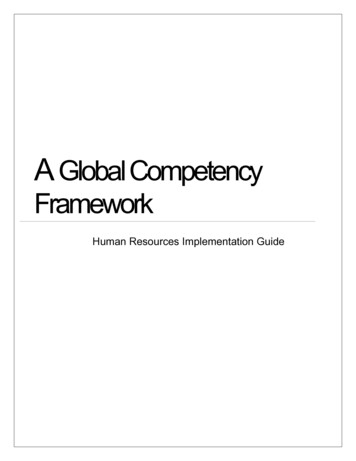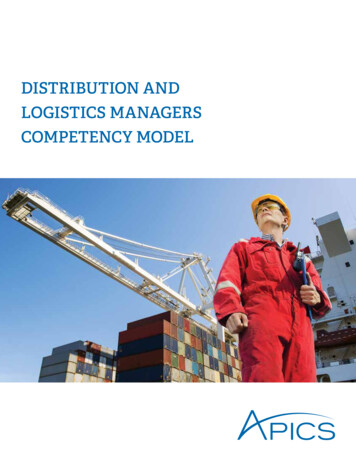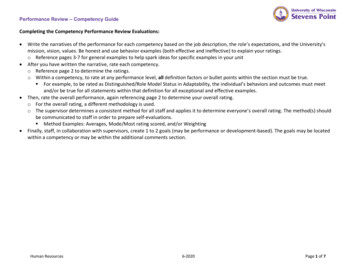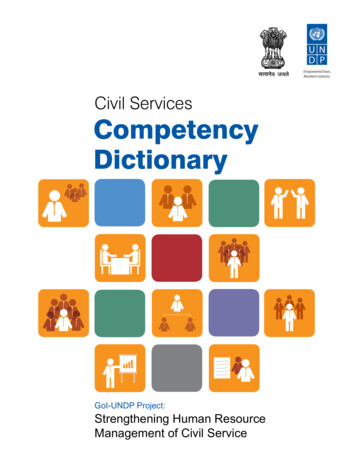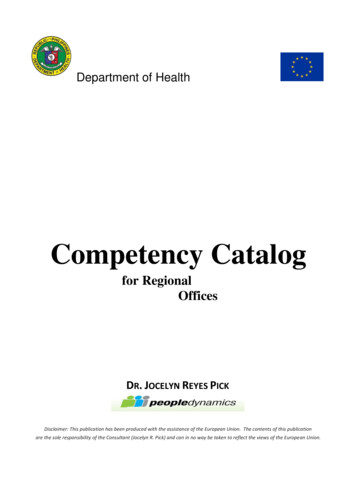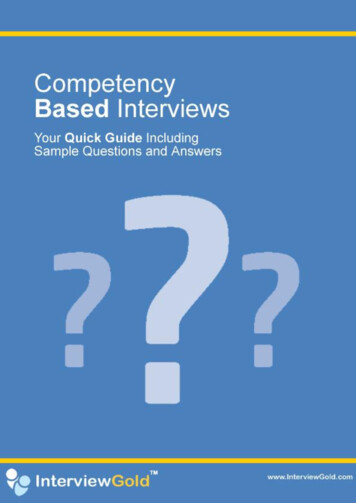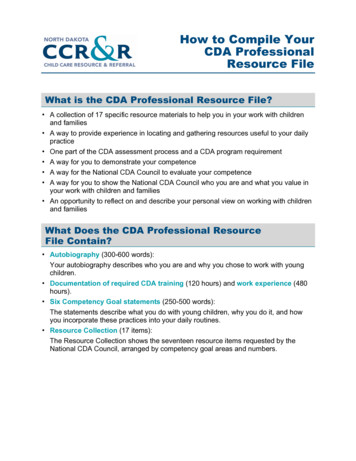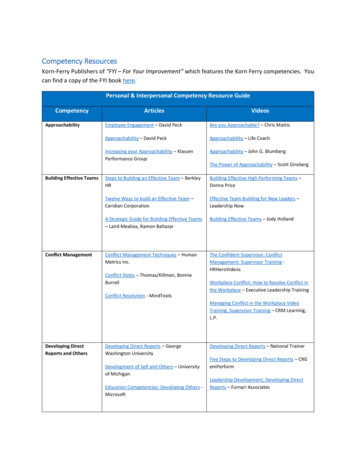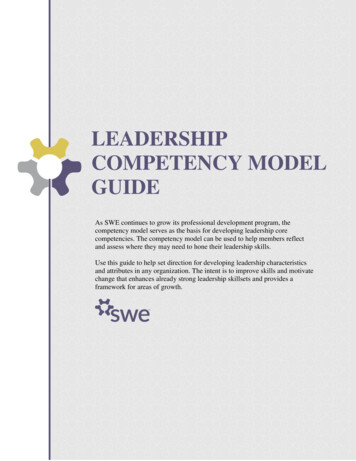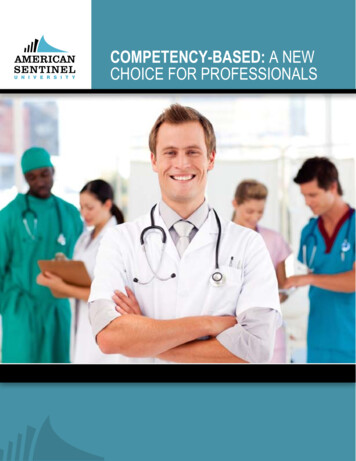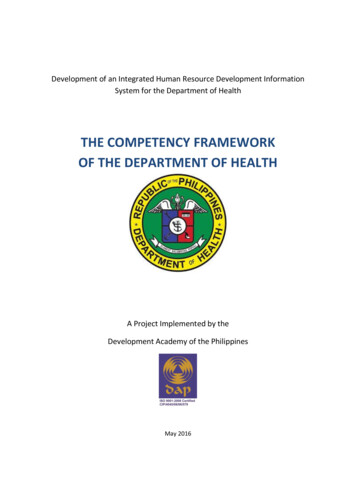
Transcription
Development of an Integrated Human Resource Development InformationSystem for the Department of HealthTHE COMPETENCY FRAMEWORKOF THE DEPARTMENT OF HEALTHA Project Implemented by theDevelopment Academy of the PhilippinesMay 2016
Executive SummaryTable of ContentsEXECUTIVE SUMMARY . Error! Bookmark not defined.1.2.1.Background.Error! Bookmark not defined.Methodology .Error! Bookmark not defined.Results .Error! Bookmark not defined.INTRODUCTION . Error! Bookmark not defined.THE DOH COMPETENCY FRAMEWORK . Error! Bookmark not defined.SECTION I: CORE COMPETENCIES . Error! Bookmark not defined.1.2.3.4.Organizational Commitment .Error! Bookmark not defined.Integrity .Error! Bookmark not defined.Quality Service Focus .Error! Bookmark not defined.Self-Development .Error! Bookmark not defined.SECTION II: LEADERSHIP COMPETENCIES . 41.2.3.4.Change Management . 5Developing People . 10Partnering and Networking . 14Performance Management . 18SECTION III: TECHNICAL COMPETENCIES . cal expertise on Administration Support Services . 23Technical expertise on Career development . 27Collaboration . 32Computer Literacy . 35Conceptual Thinking . 38Technical Expertise on Government Accounting and Budgeting. 41Technical Expertise on Records Management . 44Technical Expertise – Learning and Development Management . 47Program/Project Management . 52Technical Expertise – Local Health Systems . 57Development . 57Managing Information . 61Policy Development . 64Political Savvy . 68technical expertise – Recruitment & Selection and . 72Placement. 72Technical Expertise on Leave and Compensation Administration. 76Technical Expertise on Performance Management System Implementation . 79
Executive Summary20.21.Formal Presentation/Speaking Effectively . 83Technical Writing. 87
Section 2 – Leadership CompetenciesMay 2016SECTION I: LEADERSHIP COMPETENCIESLeadership Competencies are functional competencies shared by leaders / managers and areneeded for the efficient and effective management of organizational resources, including people.These competencies relate to skills, knowledge and behaviors needed to perform managerial workand processes that involve interaction with individuals or groups. Common examples includePlanning and Organizing, Decision Making and Developing Others.
Section 2 – Leadership CompetenciesMay 20161. CHANGE MANAGEMENTType of Competency: Leadershipa. Competency DictionaryCOMPETENCY TITLEManaging ChangeGENERAL DEFINITIONThe ability to plan, develop and manage a structured approach to prepare individuals and groups fora change initiative and to transition them from a current state to a desired future state in a positiveand constructive manner to minimize negative impact and possible resistance.KEY BEHAVIORS Recognizes the need to change organizational goals and targets, processes and procedures,structures, positions, work assignments and/or other factors that affect organizationaleffectivenessDetermines what needs to be changed and how to effect the changePlans and communicates the change initiative to all those who will be affectedManages and leads the change process in order to lessen the negative impact or likelyobjections to the changeIdentifies and takes steps to minimize negative impact of change that may lead to conflictsamong affected partiesSeeks guidance and support from other individuals in resolving difficult problems that arebeyond one’s jurisdiction and capacityManages internal and external relationships in ways that promote the best interest of allparties
Section 2 – Leadership CompetenciesMay 2016KNOWLEDGE Organizational VMG,thrusts, culture, valuesOrganizational structure,processes, systems andpoliciesDevelopment of ChangeManagement PlanCommunication planRationalization planGlobal, national, localtrends and developmentsProfile of internal andexternal clientsChange managementconceptsConcepts of humanrelations and conflictmanagement strategiesQuality ManagementsystemRelevant legislation,government policies andemerging issuesCode of conduct and ethicalstandards; CSC rules andregulations; Grievanceprocedures and policiesSKILLS Human/public relationsCommunicationNegotiation and bargainingPlanningMotivatingNegotiationHuman relationsEmphatic ListeningInterviewingDecision makingFacilitationStakeholder analysisATTITUDE Open-mindedRisk estMaintains confidentiality
Section 2 – Leadership CompetenciesMay 2016b. Competency with Definition and RubricsCompetency Title: Managing ChangeDefinition: The ability to plan, develop and manage a structured approach to enable individuals and groups to prepare for change and to transition themfrom a current state to a desired future state in a positive and constructive manner to minimize negative impact and possible resistance.LEVELSCOREDESCRIPTION BASIC/LEARNING1Understands rationale for thechange and activelyparticipates in the conduct ofthe change initiative byexplaining the need or reasonfor changeAssists in the mitigatingpossible resistance to changethat may lead to conflictsamong employees.INTERMEDIATE/PROFICIENT2 Takes the lead inimplementing plannedactivities in a change initiative Moderates conflicts arisingfrom changes being made ADVANCED3Leads in the implementation ofa change management planthat involves one or moreoffices, systems and/orprocessesResolves conflicts that mayemanate from changes beingmade BEHAVIORALINDICATORS Explains the rationale for thechange initiative toemployees who will beaffected by the changeIdentifies key messages to beincluded in the changemanagement communication Directs change managementactivities affecting one’sfunctional area or expertiseby enlisting activeparticipation of keyindividuals in the unitIs able to explain the Develops a changemanagement plan and itsaccompanying communicationplan and policies (2 or moreoffices, processes andsystems) SUPERIOR/EXPERT4Directs the implementationof a change managementplan that impacts the entireorganization and directlyaffects all functions,processes, systems andindividuals.Handles resolution ofconflicts between internaland external groupsSets policies, proceduresand standards for conflictresolutionKeeps abreast of relevantlegislation, governmentpolicies and emerging issuesto anticipate the need forchange within theorganizationDevelops a change
Section 2 – Leadership CompetenciesMay 2016LEVELS BASIC/LEARNING1planParticipates in theimplementation of the changemanagement processIdentifies and refers toappropriate persons withinthe organizational unit difficultproblems or possible conflictsthat may arise and that arebeyond one’s jurisdiction andcapacity INTERMEDIATE/PROFICIENT2implications on the unit and/or organization if changeis not implementedIs able to make office policyadjustments to minimize the negative impact of change onpeopleDevelops communicationstrategies to deliver key messages to help employeesunderstand the change. Assists in the implementationof organization-wide changeby collecting informationuseful to manage the change,assessing people’s perception and recommendingalternative options to makechange implementation moresuitable. Seeks guidance and supportfrom other knowledgeableindividuals within theorganizational unit inresolving difficult problemsthat are beyond one’s jurisdiction and capacityADVANCED3Identifies possible threats andrisks as a result of change andrecommends measures tominimize risks.Evaluates effectiveness of riskmanagement strategies andprovides insight on those thatneed improvement or revision.Leads in the implementationof the change.Sets up mechanisms forsustaining change, developingchange agents andcontinuously motivating peopleto support the change.If needed, obtains resources toimplement the changemanagement andcommunication plans.Updates oneself with relevantpolicies and issues that impacton the change managementand communication plans andmakes necessary adjustmentsor improvements.Facilitates the development oflong-term resolutions toconflict situations caused bythe change SUPERIOR/EXPERT4management plan and itsaccompanying policies andcommunication plan(organization-wide)Leads in theimplementation oforganization-wide changeMonitors theimplementation oforganization-wide changeand if warranted, makesthe necessary revisions tothe change managementand communication plans.Provides resources toenable the change processto happen.Sustain a culture of changeand fosters a culture ofsupportive interpersonalrelationships amonginternal and externalparties
Section 2 – Leadership CompetenciesMay 2016LEVELSBASIC/LEARNING1INTERMEDIATE/PROFICIENT2 MOV Activity reportsKey messages identifiedDPOs, notices of meeting Prepares activity reportsIdentifies key messages (?)Prepares DPOs and notices ofmeetings Change management plan(office or unit level)Communication plan(office orunit level)Minutes of grievancecommittee meetingsDocumented policy changesProgress and EvaluationreportDevelops change managementplan (office or unit level)Develops communicationplan(office or unit level)Prepares minutes of grievancecommittee meetingsDocuments policy changesPrepares Progress andEvaluation report ADVANCED3Keeps abreast of theimplementation of resolutionsthat serve the interests of allparties affected by the changeChange management plan (2 ormore offices, processes andsystems)Communication plan (2 ormore offices, processes andsystems)Progress and Evaluation reportwith recommendationsDevelops change managementplan (2 or more offices,processes and systems)Develops communication plan(2 or more offices, processesand systems)Prepares Progress andEvaluation report withrecommendationsSUPERIOR/EXPERT4 Change management planwith risk managementstrategies (organizationallevel)Change managementpoliciesPolicy brief or othertechnical advocacy materialsM&E ReportDevelops changemanagement plan with riskmanagement strategies(organizational level)Develops changemanagement policiesDevelops policy brief orother technical advocacymaterialsPrepares M&E Report
Section 2 – Leadership CompetenciesMay 20162. DEVELOPING PEOPLEType of Competency: Leadershipa. Competency DictionaryCOMPETENCY TITLEDeveloping PeopleGENERAL DEFINITIONThe ability to plan and support learning and career growth and development of individuals and/or teams sothat they can fulfill current or future jobs/roles and responsibilities effectivelyKEY BEHAVIORS Validates competency gaps of subordinates and identifies their strengths and weaknessesIntervenes in the development of the staff by running simple solutions in closing competency gapssuch as coaching, peer teaching and other basic learning and development interventionsDetermines professional career goals of individual staff and influences staff/team to design a personalplan towards the achievement of their aspirationsDesigns/creates special development package for high achievers in preparation for succession planningwithin the office/organizationKNOWLEDGE VMG of the OrganizationOrganizational systems andprocedureConcepts of CareerDevelopmentConcepts of Human ResourceManagement andDevelopment SystemsCareer Development andManagement ToolsDOH positions, functions andqualification standardsSKILLS Communication (Oral andWritten)MentoringCounsellingMotivatingDecision MakingCreative10ATTITUDE Considerate/sensitiveCredibleProfessionalUnbiased, impartial,balanced, reasonableDiplomatic, tactfulInspires confidence
Section 2 – Leadership CompetenciesMay 2016b. Competency with Definition and RubricsCompetency Title: Developing PeopleDefinition: The ability to plan and support learning and career growth and development of individuals and/or teams so that they can fulfill current or futurejobs/roles and responsibilities effectivelyLEVELSLEARNING1COREDESCRIPTION Determines gaps in the skills,knowledge and attitudes ofemployees using standardtools and analysis BEHAVIORALINDICATORS Identifies strengths andweaknesses of staff/teammembers Validates competency gapsof individual staff Guides staff in identifyingprofessional career goalswithin the organization INTERMEDIATE/PROFICIENT2Identifies and recommendsavailable learning anddevelopment interventions toaddress gaps of employeesIdentifies and assignsappropriate learning anddevelopment interventions foreach staff based on confirmedgaps and identified career goalsProvides guidance on thedifferent options towards theimplementation of individualcareer development plans ofstaff/ team membersDialogues with team to urge11ADVANCED3SUPERIOR, EXPERT4 Designs learning anddevelopment interventionsand partners withstakeholders in leadingemployees towards aperformance-based culture Develops and advocates policiesand practices to ensure theappropriate mix of employeeskills, knowledge and abilities sothe organization can achieve itsstrategic goals. Recommends and/or designslearning and developmentinterventions appropriate forthe team Develops office policies, processesand/or mechanisms for staffdevelopment and talentmanagement Provides staff members withopportunities for careergrowth and development bypartnering with stakeholders Designs/creates specialdevelopment package for highachievers in preparation forsuccession planning within theoffice/organization Conducts mentoring andcoaching towards thepersonal and professional Engages and motivates individualsand teams in creating a
Section 2 – Leadership CompetenciesMay 2016LEVELSMOVLEARNING1 Individual Learning andDevelopment NeedsAssessment (LDNA) resultsIndividual CareerDevelopment PlansIndividual PerformanceCommitment and Review(IPCR)Interprets individual Learningand Development NeedsAssessment (LDNA) resultsHelps in preparing IndividualCareer Development PlansCites references to IndividualINTERMEDIATE/PROFICIENT2them to complement eachother’s strengths and weaknessin order to address challengingsituations within theorganizational unit Learning and DevelopmentIntervention (LDI) PlanCareer Development PlanADVANCED3growth of staff/teamMonitors progress inimplementing IndividualCareer Development Plans Leverages investments anddevelops budget proposalsrelative to staff development andtechnologies for talentmanagement Level 3 Evaluation ReportsDepartment PerformanceCommitment and Review(DPCR)Individual PerformanceCommitment and Review(IPCR)Career Development PlanRequests/recommendationsfor LDISemestral monitoring reportsPrepares Level 3 EvaluationReportsCites references/adjustmentsto Department PerformanceCommitment and Review(DPCR) Office policies/proceduresWFPIndividual staff portfolioSuccession PlanOrganizational PerformanceCommitment & Review (OPCR) Prepares officepolicies/proceduresCompletes WFPConfirms individual staff portfolioDocuments Succession PlanCites references/adjustments to Prepares Learning andDevelopment Intervention (LDI)PlanDocuments enhancements tothe Individual CareerDevelopment Plan12performance-based culture SUPERIOR, EXPERT4
Section 2 – Leadership CompetenciesMay D3 Performance Commitmentand Review (IPCR) 13Checks/confirms results ofIndividual PerformanceCommitment and Review(IPCR)Documents changes oradditional improvements onthe Individual CareerDevelopment PlanPrepares requests andrecommendations for LDIPrepares semestralmonitoring reportsSUPERIOR, EXPERT4Organizational PerformanceCommitment & Review (OPCR)
Section 2 – Leadership CompetenciesMay 20163. PARTNERING AND NETWORKINGType of Competency: Leadershipa. Competency DictionaryCOMPETENCY TITLEPartnering and NetworkingGENERAL DEFINITIONThe ability to build, develop, expand and utilize collaborative relationships with local andinternational partners to facilitate the accomplishment of DOH goalsKEY BEHAVIORS Identifies relevant stakeholders needed to achieve organizational goalsAligns common goals between and among partnersIdentifies opportunities for collaborationFacilitates and expands formal partnerships in local and international networksKNOWLEDGE Contract managementStakeholder analysisPrinciples of networkingConcept on negotiationprocessesConcept on groupdynamicsConcepts on humanrelationsSKILLS CommunicationContract managementHuman relationsNetworkingFacilitationCollaborationSocial marketingNegotiationPolitical Savvy14ATTITUDE ed/ objectiveConsiderate
Section 2 – Leadership CompetenciesMay 2016b. Competency Definition and RubricsCompetency Title: Partnering and NetworkingDefinition: The ability to build, develop, expand and utilize collaborative relationships with local and international partners to facilitate the accomplishmentof DOH C/LEARNING1 INTERMEDIATE/PROFICIENT2 Maintains existing localpartnerships and networksto deliver or enhance workoutcomesMaintains contact withpeople in differentorganizations who can beuseful sources of informationor resources and capitalizeson these to deliver orenhance work outcomesMonitors and acts on localpartnership arrangements toensure that the objective ofthe partnership remain ontarget.Builds or expands localpartnerships and networksand capitalizes on these todeliver and enhance workoutcomes Identifies opportunities forcollaboration with localstakeholders Translates stakeholder inputsinto recommendations andproposals ADVANCED3 Maintains existinginternational partnershipsand networks to deliver orenhance work outcomesBuilds or expands oninternational partnershipsand networks and capitalizeson these to deliver orenhance work outcomes Maintains contact withinternational partners andcapitalizes on these to reachcommon goals Seeks opportunities forcollaboration with foreignpartners and diverse groups ofpeople across culture and race Monitors and acts oninternational partnershipagreements to ensure that theobjectives of the partnershipare met Forges and conforms toagreements/understandingwith internationalstakeholders to achievecommon goals Develops the necessarypolicies and structures tosustain and maximize thebenefits of partnerships withCreates partnerships anddevelops strategies with localstakeholders to meet mutuallybeneficial goals Stays alert and informed ofpolitical, cultural environmentaffecting the partnershipFacilitates dialogue regardingcommon concerns and Monitors the impact of15SUPERIOR/EXPERT4
Section 2 – Leadership CompetenciesMay 2016LEVELSMOVBASIC/LEARNING1 INTERMEDIATE/PROFICIENT2opinions; makes decisionsthru consensus; and proposespotential solutionsADVANCED3international partnerships Responds to feedback on whatis working, what needs areunmet and how to resolvespecific problemsDirectory of Local Partners Evidences of engagement/communication with localstakeholders (letters, memos,email)Activity report/minutes of the meetingReports or evidences ofpartnership (minutes ofmeeting, membership to TWGthroughDPO/MOU/MOA//SLAscontracts, etc.)Reports/evidences ofengagement in partnershipactivities Prepares reports or evidencesof partnership (minutes ofmeeting, membership to TWGthroughDPO/MOU/MOA//SLAscontracts, etc.) Prepares, maintains andupdates Directory of LocalPartnersPrepares Evidences ofengagement/ communicationwith local stakeholders16 SUPERIOR/EXPERT4international organizationsand networks Monitors and evaluates theimpact of internationalpartnershipsDirectory of internationalpartner agencies andorganizationsReports/evidences ofengagement in partnershipactivitiesM & E reports MOA/MOU/ other contractswith international partnersand networksPolicy instrumentsLetters of intent, partnershipsEvaluation reports, conceptpapers, researches, healthpolicy notesPrepares, maintains andupdates directory ofinternational partner agenciesand organizationsPrepares reports/evidences ofengagement in partnership Develops MOA/MOU/ othercontracts with internationalpartners and networksDevelops policy instrumentsConceptualizes and preparesletters of intent, partnerships
Section 2 – Leadership CompetenciesMay 2016LEVELS BASIC/LEARNING1(letters, memos, email)Prepares activityreports/minutes of themeetingINTERMEDIATE/PROFICIENT2 Prepares reports/evidences ofengagement in partnershipactivities17 ADVANCED3activitiesPrepares M & E reports SUPERIOR/EXPERT4Develops/prepares evaluationreports, concept papers,researches, health policynotes
Section 2 – Leadership CompetenciesMay 20164. PERFORMANCE MANAGEMENTType of Competency: Leadershipa. Competency DictionaryCOMPETENCY TITLEPerformance ManagementGENERAL DEFINITIONThe ability to plan, manage and monitor employee performance and provide timely feedback toindividuals and groups to take action and improve their performance.KEY BEHAVIORS Plans, assesses and monitors work and/or team performance using diverse indicators;Incorporates principles of quality measurement and customer satisfaction to performancemanagementProvides recognition to high performing individuals or groups and notification to those requiringperformance improvementsCarries out appropriate interventions to improve performance and/or maintain goodperformanceKNOWLEDGECharacter profiles andpersonalities of staffPrinciples of humanbehaviour and groupinterrelationshipsDifferent performancemonitoring tools andmethodsCompetency-basedperformance management(includes qualitystandards, customersatisfaction and rewardsand incentives SKILLSHR Monitoring andEvaluationHR Planning hing and Mentoring18 tialPracticalDiplomatic/TactfulSensitive
Section 2 – Leadership CompetenciesMay 2016b. Competency with Definition and RubricsCompetency Title: Performance ManagementDefinition: The ability to plan, manage and monitor employee performance and provide timely feedback to individuals and groups for them to take actionand improve their performanceLEVELSCONTEXT/COREDESCRIPTIONLEARNING1 Understands how performancemanagement is done and assiststeam members to accomplishtemplates related to SPMSprocess Explains the DOH StrategicPerformance Managementprocess and assists teammembers in accomplishing SPMSformsAligns actual workplaceperformance with targets andindicators of division/unitProvides feedback onperformance of daily tasksConsiders feedback from othersources.BEHAVIOURALINDICATORS INTERMEDIATE/PROFICIENT2 Confirms alignment ofindividual performancetargets with divisiontargets/objectivesIdentifies targets andappropriate indicatorsfor work outputsIdentifies gaps andinitiates measures toaddress performancegapsMonitors and evaluatesindividual performanceupon application s/techniques in19ADVANCED3 Substantiates alignment ofDivision Performancetargets with office targetsFormulates indicators andmeasurable targets for thedivision/unitValidates targets andreviews accomplishmentsof subordinatesCoaches by givingassessment feedback andgeneral advice aboutleveraging strengths andovercoming performancegapsMonitors and evaluatesteam/divisionperformance uponSUPERIOR, EXPERT4 Certifies alignment ofoffice performancetargets withorganizational strategicobjectives and thrustsFormulates indicatorsand measurable targetsfor the office/bureauValidates targets andreviewsaccomplishments ofdivision heads/directorsAllocates necessaryresources needed toaddress performancegaps of the organizationImplements necessaryorganizational changesneeded to addressperformance gaps of the
Section 2 – Leadership CompetenciesMay 2016LEVELSMOVLEARNING1 IPCR, RFACSS report , Minutes of MeetingsINTERMEDIATE/PROFICIENT2response to an objectiveassessment of clientfeedback Conducts sessions todiscuss performancegaps and improvementplans Recognizes andcommends highperforming individualsor groups IPCR, RFACSS reports, Minutes ofMeetingsADVANCED3application of measures Accomplishes IPCR, RFAPrepares CSS report , Minutes ofMeetings Accomplishes IPCR, RFAPrepares CSS reports,Minutes of Meetings 20 Discusses feedback andrecommends correctivemeasures to improveperformanceProvides incentives orrewards to highperformingindividuals/groupsDPCR, RFAMinutes of ManagementReviewPRAISE Committee ReportRecommendation lettersProcedures ManualPolicies, Minutes ofMeetingsAccomplishes DPCR, RFAPrepares Minutes ofManagement Review andrelated meetingsPrepares PRAISECommittee Report SUPERIOR, EXPERT4organizationMonitors and evaluatesoffice performance uponapplication of measuresDevelops incentivemechanisms to ent ReviewReportProcedures ManualPolicies, Minutes ofMeetingsAccomplishes OPCRPrepares ManagementReview ReportPrepares ProceduresManualCreates/enhances/revises
Section 2 – Leadership CompetenciesMay 2016LEVELSLEARNING1INTERMEDIATE/PROFICIENT2 21ADVANCED3Prepares recommendationlettersDevelops ProceduresManualCreates/enhances/revisesPolicy documents SUPERIOR, EXPERT4Policy documentsPrepares Minutes ofBureau/Office Meetings
Section 3 – Technical CompetenciesApril 2016SECTION III: TECHNICAL COMPETENCIESTechnical Competencies are functional competencies shared within job families and forspecific positions that support the performance of the technical or functional component ofa job.Common examples of these competencies include Attention to Detail or Process Orientationfor administrative functions, or more thematic competencies for highly specialized positionslike Financial Management or Human Resource Management or Public Health.22
Section 3 – Technical CompetenciesApril 20161. TECHNICAL EXPERTISE ON ADMINISTRATION SUPPORT SERVICESType of Competency: Technicala. Competency DictionaryCOMPETENCY TITLETechnical Expertise on Administration Support ServicesGENERAL DEFINITIONThe ability to provide complete administrative support such as document tracking and recordskeeping, supply and logistics management, administration of personnel matters, processing offinancial transactions, and other general services that will ensure effective and efficient day-to-dayoperations of the Department.KEY BEHAVIORS Assists frontline services in preparing required forms for personnel, financial, logistics and otheradministrative requisitions and transactionsCoordinates with other offices for the timely processing of requests for budget, administrativesupport and logistic requirements by the different divisions/projects in one’s Bureau/OfficeHelps in the preparation of budget by anticipating logistics and other administrative support thatmay be required by the Bureau/OfficeMonitors the proper maintenance, allocation and utilization of resourcesEstablishes appropriate records management system within one’s Bureau/OfficeKNOWLEDGECSC rules and policiesGovernment policies onprocurement, accountingand auditingDOH administrative andfinance policies andguidel
Section 2 – Leadership Competencies May 2016 b. Competency with Definition and Rubrics Competency Title: Managing Change Definition: The ability to plan, develop and manage a structured approach to enable individuals and groups to prepare for change and to transition them from a current state to a desired future
